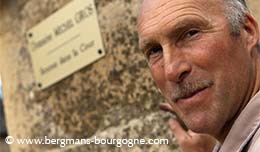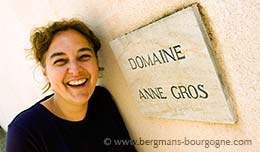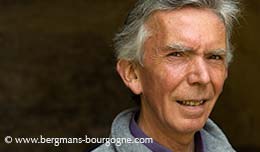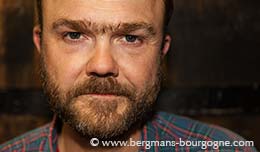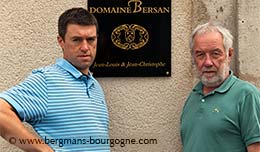
rower, vines and terroir. If you ask Loïc Dugat-Py those are the three important things if you want to make a great wine.
– At Domaine Dugat-Py the strong point is the vines, he says. My great-grandfather was a pépiniériste, a nurseryman, which means our vines are a very good sélection massale. An 80-year old sélection massale and a clone do not produce the same wine.
Loïc Dugat-Py represents the 13th generation of winegrowers in his family. He took on the domaine in 2013, but had been working alongside his father since 1997.
 – The Dugat family goes back a long, long way in Gevrey-Chambertin and Brochon. 13 generations is how far back we have managed to find documents. Before that we haven’t been able to find any.
– The Dugat family goes back a long, long way in Gevrey-Chambertin and Brochon. 13 generations is how far back we have managed to find documents. Before that we haven’t been able to find any.
– My grandfather Pierre had five or six hectares of vines. Part of it he gave to my father, part of it to my aunt, my father’s sister. During the 1990s my parents bought more land. Today we have ten hectares. This is a good size. We want to remain winegrowers, not become office workers.
The average age of the vines at Domaine Dugat-Py is generally high. For the village appellation Gevrey-Chambertin cuvée Cœur de Roy, a blend of Combe du Dessus, Epointures and Les Marchais, the youngest vines were planted some 50 years ago. The oldest were planted in 1910.
– The family vines produce very small grapes that do not rot. They always reach a good level of maturity. The vines are really our domaine’s strong point.
 – My parents held on to this philosophy, focusing on old, high quality vines. When they added vineyards to the domaine they searched for well-placed parcels of old vines. That is why we have small parcels in Meursault and Chassagne-Montrachet. The vines are 70–80 years and the yields very low. The terroir is important, but the quality of the vines is the main thing.
– My parents held on to this philosophy, focusing on old, high quality vines. When they added vineyards to the domaine they searched for well-placed parcels of old vines. That is why we have small parcels in Meursault and Chassagne-Montrachet. The vines are 70–80 years and the yields very low. The terroir is important, but the quality of the vines is the main thing.
But low yields also tend to have an impact on the price. As Loïc Dugat-Py points out, the wines of Domaine Dugat-Py are expensive.
– Our yields are often around 20 hl/ha, he continues. In Gevrey-Chambertin, Les Evocelles we are down at 15 hl/ha. In Les Evocelles the soil is thin, just 20 centimeters. The vines are very old there. The average age is 70 years and ploughing is done by horse.
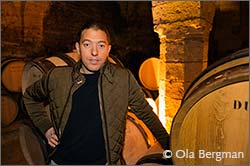 Les Evocelles is village appellation Gevrey-Chambertin. You’ll find it in the northern part of the appellation that spills over into Brochon. It is up on the slope, just next to the premier crus of Champeaux and Les Goulots.
Les Evocelles is village appellation Gevrey-Chambertin. You’ll find it in the northern part of the appellation that spills over into Brochon. It is up on the slope, just next to the premier crus of Champeaux and Les Goulots.
– Together with the Syndicat viticole de Gevrey-Chambertin we have asked to have Les Evocelles upgraded to premier cru status. The character of Les Evocelles is very sauvage, with a touch of minerality. This produces a very nice tension in the wine. I think it’s thanks to organic farming that we have managed to achieve such excellent results with a village appellation wine. We usually produce six barrels of Les Evocelles. It gets 100 per cent new oak, while Cœur de Roy gets 70 per cent. We have been using whole bunches at the domaine since the 1990s. The amount used depends on the vintage and the appellation.
 Organic wine growing at Domaine Dugat-Py began in 1999. Loïc’s father, Bernard, did some experimenting on three hectares in Chambertin and the Cœur de Roy parcels. Satisfied with the results they converted the whole domaine to organic in 2003.
Organic wine growing at Domaine Dugat-Py began in 1999. Loïc’s father, Bernard, did some experimenting on three hectares in Chambertin and the Cœur de Roy parcels. Satisfied with the results they converted the whole domaine to organic in 2003.
 – We are very happy with the results, says Loïc Dugat-Py. We have never looked back. Our vines are much healthier now. I feel that chemicals tend to even out the differences between the wines. With organic farming the difference in terroir becomes clearer. Each terroir becomes more defined. The quality of the grapes is higher. The skins are thicker.
– We are very happy with the results, says Loïc Dugat-Py. We have never looked back. Our vines are much healthier now. I feel that chemicals tend to even out the differences between the wines. With organic farming the difference in terroir becomes clearer. Each terroir becomes more defined. The quality of the grapes is higher. The skins are thicker.
For a long time Domaine Dugat-Py produced a Gevrey-Chambertin premier cru with no mention of a specific lieu-dit. It was a blend of Fonteny, La Perrière and Les Corbeaux.
– I told my father we should bottle them separately, explains Loïc Dugat-Py. We did Fonteny in 1996 and in 2009, and each time the results were extraordinary. So in 2013 we started separating the three. This means three more premier crus in our portfolio and also more work, because each cuvée is very small.
Les Corbeaux is just between the southern end of the village and the grand cru Mazis-Chambertin. Fonteny is a bit further up the slope, just next to Ruchottes-Chambertin.
 – It’s a parcel that my parents bought. The yield is 20 hl/ha. The wine has a nice spicy character. Our parcel is just 20 metres from Ruchottes, and very close to Mazis. So it’s almost a grand cru. It easily keeps for ten to 20 years.
– It’s a parcel that my parents bought. The yield is 20 hl/ha. The wine has a nice spicy character. Our parcel is just 20 metres from Ruchottes, and very close to Mazis. So it’s almost a grand cru. It easily keeps for ten to 20 years.
At the other end of the grand cru slope in Gevrey-Chambertin Domaine Dugat-Py has vines in both Mazoyères-Chambertin and Charmes-Chambertin. In total Charmes-Chambertin covers 12.24 hectares and Mazoyères-Chambertin 18.58 hectares. Mazoyères-Chambertin may be sold as Charmes-Chambertin, but not the other way around. In reality very little is labelled as Mazoyères-Chambertin. In the case of Domaine Dugat-Py they have chosen to do both. Their annual production of Mazoyères-Chambertin is between 800 to 1000 bottles. For Charmes-Chambertin it is 1800 to 2400 bottles.
– We are well-placed in Mazoyères-Chambertin. It’s a parcel of my aunt’s. At the top, not far from Chambertin. Then we have vines in Charmes-Chambertin as well, next to cousin Claude (Dugat). It is not from the Mazoyères-Chambertin parcel, but the soil is totally different. That’s why we do two different bottlings. There is more sand in Charmes-Chambertin, producing a supple and round wine. Our Charmes really is a charmer. It can be drunk young. The Mazoyères has more power.
Part of Mazoyères-Chambertin vines were planted in 1980, the rest in the 1930s. The same goes for their Charmes-Chambertin, where a parcel from Mazoyères-Chambertin also is included.
© 2016 Ola Bergman










